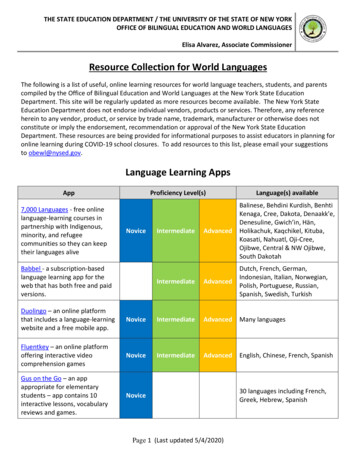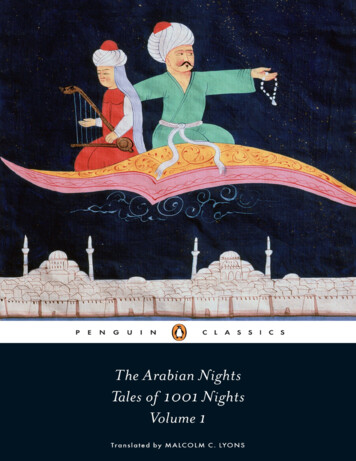
Transcription
Donna PetherbridgeECI 511, Comprehensive Unit Plan , Summer II, 2003Short StoriesEnglish IA short story is fiction – a work of literature in which the characters andevents are imagined by the author. Fiction allows you to explore newworlds, share the joys and sorrow of the characters, and learn from theinvented experiences of others. Through the short stories in this unit, wewill follow our characters as they manage family relationships in life and indeath, as the make choices that will affect their well being, as they deal withvoids in their lives, and as they stand in mortal peril. Come experience thelives of these characters, from the safety of your own seat!
ECI 511, Donna Petherbridge, Comprehensive Unit PlanShort StoriesPrimary Curriculum Area: Language ArtsAdditional Curriculum Areas: Mathematics, Information Skills, and SocialStudiesPrimary Subject Area: English IAdditional Subject Areas: Introductory Mathematics, Grade 9-12; Information SkillsGrade 9, Psychology9-12 Computer Technology SkillsSuggested Grade Level: 9th GradeEdgar Allen Poe defined a short story as a tale that could be read in one sitting. He believed shortstories could have a powerful effect on the reader, despite their brevity. As you know, shortstories are works of fiction, but you’ll find that the characters, plots, themes, settings, and otherelements are very reflective of our real lives, for who among us has not experienced what some ofthese characters experience: joy and sorrow, pain and fear, excitement and danger?The short stories in this unit are arranged thematically, focusing on the following subjects:1. Danger [Week One: In Mortal Peril]! The Cask of Amontillado - Edgar Allen Poe! The Most Dangerous Game – Richard Connell2. Decisions [Week Two: Choices]! The Lady, or the Tiger – Frank R. Stockton! The Necklace – Guy de Maupassant3. Loneliness [Week Three: Filling a Void]! The Secret Life of Walter Mitty – James Thurber! And Sarah Laughed – Joanne Greenberg! American History – Judith Ortiz Cofer4. Death [Week Four: A Death in the Family]! Before the End of Summer – Grant Moss, Jr.! The Scarlet Ibis– James Hurst5. Relationships [Week Five: Love and Family Relationships]! Uncle Marcos – Isabel Allende! All the Years of Her Life – Morley Callaghan! The Gift of the Magi – O.HenryThe stories selected for each week certainly fit into the overarching themes, yet as in all works offiction, there are often multiple themes that can be discerned and discussed as we use fiction toexplore the human condition. While reading and discussing the stories of this unit, andinterweaving writing, video viewing, and technology exercises, a solid range of language arts andtechnology curriculum objectives can be met, and depending on the story studied, othercurriculum areas can be interwoven, with examples in this unit meeting objectives inmathematics, information skills, and psychology.2
ECI 511, Donna Petherbridge, Comprehensive Unit PlanShort Stories –Included Lesson PlansWeek One: In Mortal PerilComparing Selections: “The Most Dangerous Game”and “The Cask of Amontillado” [focus: characterization] . 4Week Two: ChoicesUnderstanding Plot: “The Lady, or the Tiger?” [focus: plot] . 12Week Three: Filling a Void“The Secret Life of Walter Mitty” – One More Daydream[focus: point of view]. 22Week Four: A Death in the FamilyWriting about Theme: “The Scarlet Ibis” [focus: theme] . 32Week Five: Love and Family RelationshipsShort Story Wrap-Up [focus: applying/reviewing the elementsof the short story genre learned in the unit] . 383
ECI 511, Donna Petherbridge, Comprehensive Unit PlanLanguage ArtsCurriculumArea(s)English Language ArtsMathematicsSubject Area(s)English IIntroductory Mathematics, Grade 9-129-12 Computer Technology SkillsWeek’s ThemeWeek One: In Mortal Peril . . .These characters experience critical events that threaten their sense of wellbeing and reveal their values, characteristics, and approaches to life anddeath.Lesson TitleComparing Selections: “The Most Dangerous Game” and“The Cask of Amontillado”Suggested GradeLevelTimeEquipmentNeeded andAvailabilityEnglish I, 9th GradePrerequisite Skillsin Subject AreaOne [LanguageArts, English I)90 minutes (possible in one class session with block schedule)! Teaching computer, and projector to project the information on theinstructor computer! 5 additional computer stations in the classroom! Classroom printer, networked to all computers, including theinstructor station! All computers have Microsoft Office 2000 with Excel.! Microsoft Office Handbook that has information on using Excel isavailable for each workstation as a reference! Chalkboard and colored chalk.! Comparing Selections: “The Most Dangerous Game” and “The Caskof Amontillado” handouts (at end of lesson plan)! Grading Rubric (at end of the lesson plan)Students have completed the first week of the short story unit, and arebeginning to understand the elements of the short story as examined in thefollowing reading selections:“The Cask of Amontillado” - Edgar Allen Poe“The Most Dangerous Game” – Richard ConnellIn reading and discussing these stories, students have viewed the painting“The Hungry Lion” and discussed the “danger” of that painting, they haveread, discussed and reviewed both stories, and are beginning to develop anunderstanding of characterization and setting. They have also discussedmanhunts as depicted by movies, and how films they have seen are similar tothese stories.4
ECI 511, Donna Petherbridge, Comprehensive Unit PlanPrerequisite Skillsin Subject AreaTwo [IntroductoryMathematics,Grades 9-12]Prerequisite Skillsin Technology:LearningObjectives inSubject Area (s)[Language Artsand IntroductoryMathematics]Students are building on skills from earlier experiences with mathematics,including the ability to collect and analyze data and understanding the optionsfor displaying data (such as through graphing).Students have already spent time using the computer for earlier assignmentsthat have addressed the following skills in Excel:- Entering data in Microsoft Excel- Formatting text in Excel, including Merging and Centering- Using the AutoSum and AutoChart featuresNCDPI objectivesLanguage Arts, English I5.01 Read and analyze various literary works by: determining a character’straits from his/her actions, speech, appearance, or what others say about himor her.Introductory Mathematics, Grade 9-123.01 Collect, organize, analyze, and display data (including scatterplots) tosolve problems.LearningObjectives inTechnology:Instructions:NCDPI objectivesComputer/Technology Skills Curriculum, Grades 9-122.2 Select and use appropriate technology tools to efficiently collect, analyze,and display data.In this lesson, students will be challenged to compare the characters, theelements of suspense, and the experiences of the two stories we havecompleted reading, “The Cask of Amontillado” by Edgar Allen Poe and“The Most Dangerous Game” by Richard Connell. Keep in mind that bothstories have been read and discussed, but not compared and contrasted witheach other at this point.First part of class, approximately 35/40 minutes:Discuss “The Cask of Amontillado” and “The Most Dangerous Game” interms of comparing and contrasting these stories with the students. Studentsshould face an overhead projector or chalkboard (wherever the instructor canmost easily draw a Venn diagram to help collect and analyze data). Remindstudents that that everyone will be graded on their participation andcontributions (see rubric). Key questions to answer include, but are notlimited to:1. Who are the main antagonists in each story (Montresor and GeneralZaroff)? How are their actions, attitudes, and personality traits alike5
ECI 511, Donna Petherbridge, Comprehensive Unit Planand different?2. Zaroff and Montresor use similar strategies to attract Rainsford andFortunato. How does each man use a shared interest to lure and traphis guest?3. In what ways are Fortunato and Rainsford similar? What’s differentabout their personalities and actions?For questions 1 – 3, draw a Venn diagram on the chalkboard representing thestudent’s responses. Show them how a Venn diagram is very useful fororganizing and analyzing information, and how it provides a good, visual wayto compare and contrast different things. Use the colored chalk as the Venndiagram is drawn to visually draw attention to the comparisons/contrasts.4. How does each of the authors build suspense? Which story is moreeffective at building suspense and why?5. Which villain is scarier? How has the author used both direct andindirect methods for characterizing the villains?6. Which “victim” best handles the situation?7. Which setting is more frightening, and why?8. Which “victim” do you relate to the most? Why?Once questions 4 – 8 are completed, conduct a class poll so that everyone canhave a final “vote” on these issues. Write this on the chalkboard, and via ashow of hands, poll the class in each of these areas:CategoryScariest Villian?Best meMontresor“The Cask ofAmontillado”Fortunato“The Cask ofAmontillado”VotesNameZaroff“The MostDangerous Game”RainsfordVotes“The MostDangerous Game”Vocabulary:Characterization – The methods an author uses to reveal a character’spersonality, can be direct statements by the author or indirectly inferredthrough the character’s statements, thoughts, actions, and the statements,thoughts and actions of other charactersSetting – Time, place, context in which a story occurs.Middle of class, approximately 10/15 minutes:Class should face the area of the room with the instructor’s projectedmachine. Instructor should comment that now that the students have6
ECI 511, Donna Petherbridge, Comprehensive Unit Plancompared and contrasted these stories, and taken a poll to see which storiesand characters were the winners of our poll (scariest villain, best plot,smartest victim, most frightening setting), that students are going to workwith this data.While projecting the computer’s information to a screen all students can see,explain to each group that they will be given a “The Most Dangerous Game”and “The Cask of Amontillado” handout to work with the data we collectedduring this class poll (at end of lesson plan). Each group will then graph thedata using Excel, following the directions on the handout. Groups will alsobe asked to answer a question about why the class chose the winners, and beprepared to discuss their response with the class.The instructor should model using the AutoSum and ChartWizard functionsin Excel for the students prior to dividing them in groups, reminding themhow to graph the data and add titles, and share the grading rubric with thestudents.Divide class into groups of 3 or 4 students, creating 5 or 6 groups for the class(keeping in mind you have a total of 6 machines if necessary, as one groupcould use the instructor’s machine).Each group should be given one of the “The Most Dangerous Game” and“The Cask of Amontillado” handouts.Remainder of class, approximately 50/60 minutes:Students work in groups to chart their data, utilizing the computers in theclassroom, referring to the Microsoft Office Handbook that has informationon using Excel, and the “The Most Dangerous Game” and “The Cask ofAmontillado” handouts (at end of this lesson plan for each group).With about 10 minutes remaining, ask the groups to share their thoughtsabout the last question on their handout with the remainder of the class.Next class session (s):If needed, finish the group discussions on characterizations. Hand back thegraded group work. Will begin reading the next story in the series, “TheLady or the Tiger,” where we will build on what we have learned aboutsetting and characterization and begin studying plot in more detail, as webuild our knowledge of the genre of short story.7
ECI 511, Donna Petherbridge, Comprehensive Unit PlanEvaluation ofSubject Area One[Language Arts,English I]Evaluation ofSubject Area Two[IntroductoryMathematics,Grades 9-12 ]The instructor will note the verbal responses made by the class in the initialdiscussion to check for understanding of characterization. The instructor willpersonally reflect on the success of the lesson: did the class seem engaged inthe content? Were their responses appropriate? Meaningful? Did theyindicate depth of understanding? The instructor will also assign points on thegroups’ responses to the characterization question on their handout based onthe last item on the rubric as well as their participation in the class discussion.The instructor will note the students’ verbal responses in the initial classdiscussion that contribute specifically to the Venn diagrams on the board.Are students able to give information relevant to the diagram to beginorganizing and analyzing it in a meaningful way? The instructor will alsograde the spreadsheet, using the rubric.Evaluation ofTechnologyIntegration:Learning to utilize Microsoft Excel appropriately for projects is a necessaryskill for students. The instructor will note how well students are able to useexcel to display the information effectively. The group’s Excel charts will beassessed by the rubric. Student motivation and enthusiasm for using Excel todo this project will also be assessed.CreditsTeaching ideas, questions and options for comparing and contrastingcharacters are from the Teacher’s Wraparound Edition Glencoe Literature,The Reader’s Choice, Course 4, published by Glencoe McGraw-Hill, NewYork: 2000.8
ECI 511, Donna Petherbridge, Comprehensive Unit PlanComparing Selections:“The Most Dangerous Game” and “The Cask of Amontillado “CategoryNameScariest Villian?Best Plot?“Smartest”Victim?Most FrighteningSettingMontresor“The Cask of Amontillado”FortunatoVotesNameZaroff“The Most Dangerous Game”Rainsford“The Cask of Amontillado”“The Most Dangerous Game”VotesWe have completed comparing and contrasting the “The Most Dangerous Game” and “The Cask ofAmontillado,” and we have taken a class poll to find out people’s opinions concerning the scariestvillain, the best plot, the “smartest” victim, and the most frightening setting. You are now going toenter this information in a spreadsheet, create a graph of the data, and respond to some questions asyou give these stories some more thought.Using the chart above, copy the number of votes from the class poll from the blackboard. Then,working with your group, do the following using Microsoft Excel (note: refer to your Microsoft OfficeHandbook as needed:1. Create a New Blank document.2. In cell A1, type Comparing Selections: “The Most Dangerous Game” and “The Cask ofAmontillado“3. Merge and Center your title across cells A1 – J1.4. Make your title size 14, you can choose the font and font color.5. Type in the following table, exactly as you see it, beginning in cell A3 (Note the left handcolumn simply lets you know what to type in each cell, in the right hand column, youshould type the result of the class st VillianMontresorGeneral ZaroffNumber from poll hereNumber from poll hereBest PlotThe Cask of AmontilladoThe Most Dangerous GameNumber from poll hereNumber from poll hereSmartest VictimFortunatoRainsfordNumber from poll hereNumber from poll hereMost Frightening SettingThe Cask of AmontilladoThe Most Dangerous GameNumber from poll hereNumber from poll here9
ECI 511, Donna Petherbridge, Comprehensive Unit Plan6. For each poll, create a chart using the Chart Wizard that illustrates the results of the poll.Column, bar, and pie charts are fine. Use at least 3 different types of charts to represent yourdata. Also, make sure you do the following in the Chart Wizard:a. Give your chart a title (Titles tab, Chart Wizard).b. Show the legend for your chart on the right hand side (Legend tab, Chart Wizard).c. Show both the labels and the percent (Data Labels tab, Chart Wizard).7. Move your charts to the right of the data that you typed in, lining them up one on top of anotherUNDER the merged title. You can resize your charts so that they aren’t too large to fit underthe title where it ends in cell J1.8. Below the data that you typed in, type in the names of everyone in the group AND today’s dateon the chart.9. Use the various formatting options to make your spreadsheet attractive. Be creative and makethis look nice!10. Print out and turn into the instructor AND print out a copy for your group.11. Then, as a group, referring to your printout with the chart, discuss the following question. Beprepared to respond to this question to the remainder of the class at the end of class!Question: Review the poll data and note which story or character received the largest numberof votes for each area (scariest villain, best plot, smartest victim, most frightening setting).What elements in each story, or characteristics of each of the main characteristics, probably ledyour classmates to select the “winner”? What elements of the story or characters for the “nonwinners” still assured they got some votes?10
ECI 511, Donna Petherbridge, Comprehensive Unit PlanEvaluation Rubric for “The Most Dangerous Game”and “The Cask of Amontillado”Group Members:100 possible pointsTitle per the directionsTotalPossible10Data typed in per the directions10Chart created per the directions:- Title on chart- Legend on right of chart- Labels and percent shown10Title centered and merged per the directions10The fonts/style and formats you have chosen make thespreadsheet visually appealingGroup Names are on the spreadsheet, as well as date10You participated in and contributed to the class discussion for“The Most Dangerous Game” and “The Cask of Amontillado”15Your group was able to articulately answer this question:Question: Review the poll data and note which story orcharacter received the largest number of votes for each area(scariest villain, best plot, smartest victim, most frighteningsetting). What elements in each story, or characteristics of eachof the main characteristics, probably led your classmates toselect the “winner”? What elements of the story or charactersfor the “nonwinners” still assured they got some votes?25YourScore10Total Score:Comments:11
ECI 511, Donna Petherbridge, Comprehensive Unit PlanLanguage ArtsCurriculum Area(s)English Language ArtsInformation SkillsSubject Area(s)English IInformation Skills Grade 99-12 Computer Technology SkillsWeek Two: ChoicesThese stories focus on characters that must make a choice – can one avoidmortal peril? And the other, a lifetime of pointless sacrifice?Week’s ThemeLesson TitleUnderstanding Plot: “The Lady, or the Tiger?”Suggested Grade LevelEnglish I, Grade 9TimeEquipment Needed andAvailability90 minutes (possible in one class session with block schedule)! Teaching computer, projector to project the information on theinstructor computer! 5 additional computer stations in the classroom! Computers have floppy disk drives! All computers have Microsoft PowerPoint.! Computers should have internet access to use Microsoft’s OnlineClip Art gallery! Several copies of the Microsoft Office Handbook are available forgroups to look at.! Plot handout! “The Lady, or the Tiger?” handout! Handout on using Microsoft’s Clip Art gallery online withinstructions for inserting Clip Art into PowerPoint slides! One disk, with a blank label, is needed for each group.Prerequisite Skills inSubject Area One[Language Arts, English I]Students have completed reading the short story, “The Lady, or theTiger.” In the previous week’s lesson, students focused oncharacterization and setting in reading “The Cask of Amontillado” and“The Most Dangerous Game.” In this week’s stories, the focus will be on12
ECI 511, Donna Petherbridge, Comprehensive Unit Planplot, with the earlier stories referred to during the lesson.Prerequisite Skills inSubject Area Two[Information Skills, Grade9]As ninth graders, students are expected to form and support opinions, andwork to persuade others to their point of view. Earlier in this unit,students spent time doing this as they voted for the scariest setting andcruelest villain. This lesson will expand on this skill, asking students toform an opinion in their groups and to be prepared to support theiropinion with evidence.Prerequisite Skills inTechnology:Students have already spent time using the computer for earlierassignments that have addressed the following skills:- Using Microsoft Excel in this unit.- Using Microsoft’s online Clip Art in an earlier lesson in the year.- Using Microsoft PowerPoint to create presentations earlier in theyear.Learning Objectives inNCDPI objectivesSubject Area (s) [LanguageLanguage Arts, English IArts and Information5.01 Read and analyze various literary works by recognizing andSkills]analyzing the characteristics of literary genres, including fiction (e.g.,myths, legends, short stories, novels), non-fiction (e.g., essays,biographies, autobiographies, historical documents), poetry (e.g., epics,sonnets, lyric poetry, ballads) and drama (e.g., tragedy, comedy).Information Skills Curriculum, Grade 95.03 Describe, support an opinion, and/or persuade an audience using avariety of media formats (print, graphical, audio, video, multimedia, webbased).Learning Objectives inTechnologyNCDPI objectivesComputer/Technology Skills Curriculum, Grades 9-123.3 Select and use technological tools for class assignments, projects, andpresentations.Instructions:In this lesson, students will be examining plot by applying the concept ofplot to the story they just read, “The Lady, or the Tiger?” They will alsolearn about plot by referring to the stories they read last week, “The MostDangerous Game” and “The Cask of Amontillado.” In large part, thisshould be a review of the concept of plot learned in earlier language artscourses, but this will be a new application of the concept of plot to thestories for this unit. Once the concept of plot is reviewed, students willbreak into groups to finish the plot for the story “The Lady, or the Tiger?”as the story ends where the climax of the plot should be. In creating their13
ECI 511, Donna Petherbridge, Comprehensive Unit Planown ending, students will be working to persuade others that their endingis the most likely ending for the story, based on evidence contained in thestory.First part of class, approximately 20/25 minutes:Remind students that during the previous class, they read the short story,“The Lady, or the Tiger.” During this class, review the highlights of thisstory with the class. To discuss the story, have students move into acircle. Use the following questions to facilitate the discussion, addingmore if you wish:1. What happens to someone accused of a crime in this particularkingdom?2. Why do people in the community support this method ofpunishment? Is it fair? Why or why not? Is this any differentfrom flipping a coin?3. What crime is the young man in the story accused of committing?Why were his actions considered a crime? In your opinion, isloving someone a crime?4. Describe the actions of the young man and the princess in thearena. Does he trust her? Explain.5. What does the princess know about the lady?6. What might motivate the princess to send the young man to hisdeath? Why might she save him? Why is it important that she isdescribed as semi-barbaric as opposed to barbaric?Middle of class, approximately 30/35 minutes:While in the circle, pass to the students the Plot handout. Explain thatmost stories tell us what happens to the main characters; forexample/review:1. What happens to Rainsford in “The Most Dangerous Game” andFortunato in “The Cask of Amontillado.”2. Do these stories have some sort of “high point” and some sort of“conclusion?”3. What should/is the high point of the story, “The Lady, or theTiger?”Review the concept of plot with the students referring to the plot handout.Fill in one or two things that happen at each point of the plot in each ofthese short stories.Students will note that with the story, “The Lady or the Tiger,” the storyends at the climax. The question the climax (the emotional high point ofthe story) should have answered would logically be the result of whatcame out of the door. But the author doesn’t tell us what came out of thedoor, so he leaves it to us to decide! Explain to students that since thedecision is up to us, students will work in groups to decide what the14
ECI 511, Donna Petherbridge, Comprehensive Unit Planclimax of the story should be, and why. Each group will not only have toprovide the ending of the story, but they must persuade the rest of us thattheir opinion of the ending is the likely one, and that they will do this bycreating a PowerPoint presentation that they will share with the classduring the next class period.Divide class into groups of 3 or 4 students, creating 5 or 6 groups for theclass (keeping in mind you have a total of 6 machines if necessary, as onegroup could use the instructor’s machine).Each group should be given one of the “The Lady, or the Tiger?”handouts (at end of this document).Remainder of class, approximately 40/50 minutes:Students work in groups to form an opinion of the climax of the story,following the directions in the “The Lady, or the Tiger?” handout inorder to complete their PowerPoint presentations. They can refer to theMicrosoft Office Handbook that has information on using PowerPoint ifthis guide is needed, and the guide for using Microsoft’s Online Clip ArtGallery, if needed. As the students have used PowerPoint prior to thisactivity in earlier units in the course, no major problems are anticipated.Most of their work should center on deciding the climax of the plot, andin justifying their decision.Evaluation of Subject AreaOne[Language Arts, English I]Next class session (s):Each group will present their PowerPoint presentation to the class, andtheir presentation AND the content contained within will comprise theirgrade.The instructor will note the verbal responses made by the class in theinitial discussion to check for understanding of the concept of plot, andwill see how well the students are able to apply this concept to earlierstories that they have read. The instructor will personally reflect on thesuccess of the lesson: did the class seem engaged in the content? Weretheir responses appropriate? Meaningful? Did they indicate depth ofunderstanding? Did the groups seem engaged in working together toprovide a climax to the story as required? Was their opinion supported, asnoted on the rubric?Evaluation of Subject AreaTwo[Information Skills, Grade9]Was the group’s PowerPoint appropriate to the audience and purpose?Was the group able to describe and support an opinion? Was theirpresentation persuasive? This is graded on the rubric.Evaluation of TechnologyIntegration:Learning to utilize multimedia software, such as PowerPoint, is anexpected skill for students. The handout asks for some specific items tobe included in the PowerPoint presentation, and the groups will be gradedon their inclusion and their presentation.15
ECI 511, Donna Petherbridge, Comprehensive Unit PlanCreditsImages are from the Microsoft Clip Art Gallery Online(http://dgl.microsoft.com/)Teacher’s Wraparound Edition Glencoe Literature, The Reader’s Choice,Course 4, published by Glencoe McGraw-Hill, New York: 2000. (Forinformation on plot and good questions to ask for this short story)16
ECI 511, Donna Petherbridge, Comprehensive Unit PlanPlotPLOT: The sequence of events in a story, each event causing or leading to the next event. Plot isoften created through conflict, a struggle between opposing characters (or a struggle between thecharacter and some force, such as nature, or something internal, such as a struggle to make a decision).External conflict: one between a character and an outside force, such as another character, nature,society, or fateInternal conflict: takes place within the mind of a character who is torn between opposing feelings orbetween different courses of actionMost plots develop in 5 stages:1. Exposition: introduces the story’s characters, setting and conflict.2. Rising action: occurs as complications, twists, or intensifications of the conflict occur.3. Climax: the emotional high point of the story.4. Falling action: the logical result of the climax.5. Resolution: the final outcome of the story.There is a 6th stage of plot in some stories:6. Denouement: after the final outcome of the story, further information, a footnote, some otherinformation that adds to the storyThe Cask of AmontilladoExpositionRising ActionClimaxFalling ActionResolutionRising ActionClimaxFalling ActionResolutionThe Lady, or the TigerExpositionRising ActionClimaxFalling ActionResolutionThe Most Dangerous GameExposition17
ECI 511, Donna Petherbridge, Comprehensive Unit Plan“The Lady, or the Tiger?” - PLOT”And so I leave it with you: Which came out of the opened door – the lady, or the tiger?”tiger?” – Frank StocktonAs part of developing our understanding of the concept of PLOT, you will work in groups to write the climax(the highest point of emotional interest) for Frank Stockton’s short story, “The Lady, or the Tiger.” Not onlywill you decide what came out of the door, you will support this opinion with clear evidence from the story!You will be creating a PowerPoint presentation, which you will share with the class, to show us what yourgroup believes was behind the door the young man was directed to open by the princess. By following thedirections on this handout carefully, you will be well on your way to creating an excellent presentation thatprovides an informed opinion on what you believe came out of that door!Directions:1. Decide on a group name, and tell the instructor what y
Short StoriesShort Stories English I English I A short story is fiction – a work of literature in which the characters and events are imagined by the author. Fiction allows you to explore new worlds, share the joys and sorrow of the characters, and learn from the invented experiences of others. Th










